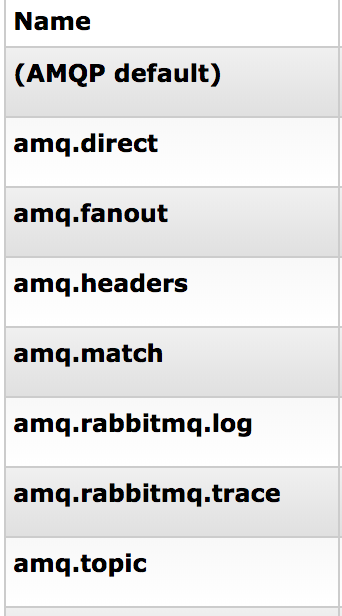RabbitMQ学习
AMQP
AMQP
高级消息协议, 消息代理 FROM 消息生产者 GET 消息 GIVE TO 消息消费者 BY 路由规则
AMQP 0-9-1
AMQP 0-9-1 工作流程:消息生产者将消息发给交换机,交换机再根据路由规则,将消息发给消息消费者。
-
发布者 可以在消息上指定各种消息属性,有些属性可以被消息代理使用, 有些则会透传给消息消费者。
-
AMQP 模型为了尽可能保证消息到达,具有ACK机制,当消息发给消费者之后,等待消费者发出ACK动作表明消息接收到,这个可以是自动的也可以由处理消息的应用的开发者执行。当“消息确认”被启用的时候,消息代理不会完全将消息从队列中删除,直到它收到来自消费者的确认回执。
-
队列,交换机和绑定统称为AMQP实体
-
AMQP 是一个可编程的协议, 某种意义上说AMQP的实体和路由规则是由应用本身定义的,而不是由消息代理定义。包括像声明队列和交换机,定义他们之间的绑定,订阅队列等等关于协议本身的操作。
交换机
交换机是用来发消息的AMQP的实体,交换机拿到一个消息之后会把消息发给 >= 0 个队列,至于使用哪种路由算法,则由交换机类型和被绑定的规则决定,下面是四种交换机:
- 直连交换机(DIRCET)
'' or 'amq.direct' - 扇形交换机(FOUNT)
amq.fanout - 主题交换机(TOPIC)
amq.topic - 头交换机 (HEADER)
amq.match
除了交换机类型之外,声明交换机的时候还可以指定一些属性:
- Name
- Durablity
- Auto-delete
- Argument
交换机可以有两个状态:持久(durable)、暂存(transient)。持久化的交换机会在消息代理(broker)重启后依旧存在,而暂存的交换机则不会(它们需要在代理再次上线后重新被声明)。然而并不是所有的应用场景都需要持久化的交换机。
默认交换机
默认交换机是消息代理默认生成的一个没有名字的直连交换机,它有一个特殊的属性使得它对于简单应用特别有用处:那就是每个新建队列(queue)都会自动绑定到默认交换机上,绑定的路由键(routing key)名称与队列名称相同。
🌰 当你声明了一个名为"search-indexing-online"的队列,AMQP代理会自动将其绑定到默认交换机上,绑定(binding)的路由键名称也是为"search-indexing-online"。因此,当携带着名为"search-indexing-online"的路由键的消息被发送到默认交换机的时候,此消息会被默认交换机路由至名为"search-indexing-online"的队列中。换句话说,默认交换机看起来貌似能够直接将消息投递给队列,尽管技术上并没有做相关的操作。
Demo
消息接受者
import pika
import time
credentials = pika.PlainCredentials('guest', 'guest')
connection = pika.BlockingConnection(pika.ConnectionParameters(host='localhost', port=5672, credentials=credentials))
channel = connection.channel()
# 生命Q
queue_result = channel.queue_declare(queue='demo_default_q')
queue = queue_result.method.queue
def callback(ch, method, properties, body):
time.sleep(1)
print method
print properties
print body
# 接受消息, 指定接受的队列
channel.basic_consume(callback,
queue=queue,
)
print 'start consuming'
channel.start_consuming()
消息发送者
#!/usr/bin/env python
import pika
import time
# 链接rabbitmq
credentials = pika.PlainCredentials('guest', 'guest')
connection = pika.BlockingConnection(pika.ConnectionParameters(host='localhost', port=5672, credentials=credentials))
channel = connection.channel()
body = "hello world"
# exchange = '' 表示使用默认交换机,往默认交换机上发消息,并且带着routingkey
channel.basic_publish(exchange='',
routing_key='demo_default_q',
body=body)
print 'send success, body :%s' % body
connection.close()
直连交换机
直连交换机是根据消息携带的路由键将消息发给同名的队列,直连交换机是处理单播路由的
-
将一个队列绑定到一个交换机上,并赋予该绑定一个与队列名字同样的路由键
-
当带着R路由键的消息发给直连交换机之后,交换机会将这个消息路由给同样为R的队列
直连交换机经常用来循环分发任务给多个工作者(workers)。当这样做的时候,我们需要明白一点,在AMQP 0-9-1中,消息的负载均衡是发生在消费者(consumer)之间的,而不是队列(queue)之间。
demo
消息接受者
import pika
import time
credentials = pika.PlainCredentials('guest', 'guest')
connection = pika.BlockingConnection(pika.ConnectionParameters(host='localhost', port=5672, credentials=credentials))
channel = connection.channel()
# 声明一个直连交换机E
channel.exchange_declare(exchange='demo_exchange_direct', exchange_type='direct')
# 声明一个Q
channel.queue_declare(queue='demo_direct_q')
def callback(ch, method, properties, body):
time.sleep(1)
print body
# 将E和Q绑定
channel.queue_bind(exchange='demo_exchange_direct', queue='demo_direct_q')
# 这个Q接受消息,不带routingkey,因为直连交换机会将Q和key同名
channel.basic_consume(callback,
queue='demo_direct_q',
)
print 'start consuming'
channel.start_consuming()
消息发送者
#!/usr/bin/env python
import pika
import time
credentials = pika.PlainCredentials('guest', 'guest')
connection = pika.BlockingConnection(pika.ConnectionParameters(host='localhost', port=5672, credentials=credentials))
channel = connection.channel()
# 声明一个直连交换机E
channel.exchange_declare(exchange='demo_exchange_direct', exchange_type='direct')
# 由于往直连交换机带rutingkey发送消息,会被自动转发给 与该E绑定的且与routingkey同名的Q
body = "hello world"
channel.basic_publish(
exchange='demo_exchange_direct',
routing_key='demo_direct_q',
body=body)
print 'send success, body :%s' % body
connection.close()
AMQP的Q和E和绑定调理很清晰的, 我大致梳理一下思路:
- 消息发送者
1.1 声明一个交换机E
1.2 向这个交换机发送带routingkey的消息2 消息接受者
2.1 声明一个交换机E
2.2 声明一个队列Q
2.3 将这个Q和E绑定 (如果不显式绑定一个Q和E, 则Q默认绑定到默认交换机)
2.4 接受Q过来的消息(可以带routingkey, 也可以不带)⚠️ 当不显示声明一个交换机E的时候,可以使用rabbitMQ默认提供的几个交换机,当不显式将Q和E绑定起来的话,则会默认将Q绑定到明为
''的E上

扇行交换机
扇形交换机 将消息发送到绑定该交换机上的所有队列,而不在意路由键,当消息发给队列的时候,会copy消息发给所有队列。
🌰消息队列,交换机,绑定关系
my-exchange ---my-routing-key1--- my-queue1
+--my-routing-key2--- my-queue2
+--my-routing1-key1-- my-queue3
给 my-exchange, my-routing-key* 发消息,my-queue1 和 my-queue2 会收到,my-quque3 收不到
demo
消息接受者
import pika
import time
credentials = pika.PlainCredentials('guest', 'guest')
connection = pika.BlockingConnection(pika.ConnectionParameters(host='localhost', port=5672, credentials=credentials))
channel = connection.channel()
exchange_result = channel.exchange_declare(exchange='demo_exchange_fanout', exchange_type='fanout')
queue_result = channel.queue_declare(queue='demo_fanout_q')
print exchange_result
print exchange_result.method
queue = queue_result.method.queue
def callback(ch, method, properties, body):
time.sleep(1)
print body
channel.queue_bind(exchange='demo_exchange_fanout', queue='demo_fanout_q')
channel.basic_consume(callback,
queue='demo_fanout_q',
)
print 'start consuming'
channel.start_consuming()
消息发送者
#!/usr/bin/env python
import pika
import time
credentials = pika.PlainCredentials('guest', 'guest')
connection = pika.BlockingConnection(pika.ConnectionParameters(host='localhost', port=5672, credentials=credentials))
channel = connection.channel()
channel.exchange_declare(exchange='demo_exchange_fanout', exchange_type='fanout')
body = "hello world"
channel.basic_publish(
exchange='demo_exchange_fanout',
routing_key='',
body=body)
print 'send success, body :%s' % body
connection.close()
⚠️ 可以把接受者启动多个不同名的队列,这样发送者发送消息,将会全部送达给绑定该E的消息接受者,而不关心routingkey
主题交换机
主题交换机 将带着路由键的消息发给 交换机和队列且路由键匹配的绑定上
demo
消息接受者
import pika
import time
credentials = pika.PlainCredentials('guest', 'guest')
connection = pika.BlockingConnection(pika.ConnectionParameters(host='localhost', port=5672, credentials=credentials))
channel = connection.channel()
exchange_result = channel.exchange_declare(exchange='demo_exchange_topic', exchange_type='topic')
queue_result = channel.queue_declare(queue='demo_topic_q')
def callback(ch, method, properties, body):
time.sleep(1)
print body
channel.queue_bind(exchange='demo_exchange_topic', queue='demo_topic_q', routing_key='demo.*')
channel.basic_consume(callback,
queue='demo_topic_q',
no_ack=True
)
print 'start consuming'
channel.start_consuming()
消息发送者
#!/usr/bin/env python
import pika
import time
credentials = pika.PlainCredentials('guest', 'guest')
connection = pika.BlockingConnection(pika.ConnectionParameters(host='localhost', port=5672, credentials=credentials))
channel = connection.channel()
channel.exchange_declare(exchange='demo_exchange_topic', exchange_type='topic')
body = "hello world"
channel.basic_publish(
exchange='demo_exchange_topic',
routing_key='demo.topic',
body=body)
print 'send success, body :%s' % body
connection.close()
⚠️ 消息接受者 的 routing_key 必须是
.分割, 可以用*代表一个任意单词,#代表0个或者多个单词 (ps 当然用 除了.之外的其他字符表示routing_key也可以,但是都不会在*/#上起作用)
小提示:
- 如果不知道python具体接口和文档, 使用help(model) 即可,比如 help(pika)
头交换机
头交换机使用多个消息属性来代替路由键建立路由规则。通过判断消息头的值能否与指定的绑定相匹配来确立路由规则.
头交换机可以视为直连交换机的另一种表现形式。头交换机能够像直连交换机一样工作,不同之处在于头交换机的路由规则是建立在头属性值之上,而不是路由键。路由键必须是一个字符串,而头属性值则没有这个约束,它们甚至可以是整数或者哈希值(字典)等